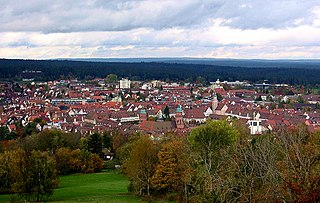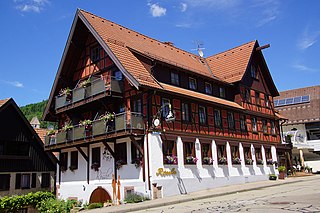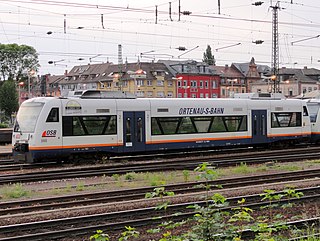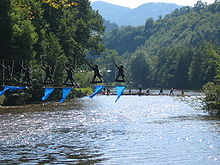
The Black Forest is a large forested mountain range in the state of Baden-Württemberg in southwest Germany, bounded by the Rhine Valley to the west and south and close to the borders with France and Switzerland. It is the source of the Danube and Neckar rivers.

The Brigach is the shorter of two streams that jointly form the river Danube in Baden-Württemberg, Germany. The Brigach has its source at 925 m (3,035 ft) above sea level within St. Georgen in the Black Forest. The Brigach crosses the city Villingen-Schwenningen. 40.4 km (25.1 mi) from the source, the Brigach joins the Breg in Donaueschingen to form the Danube River.
Ortenaukreis is a Landkreis (district) in the west of Baden-Württemberg, Germany. Neighboring districts are Rastatt, Freudenstadt, Rottweil, Schwarzwald-Baar and Emmendingen. To the west it borders the French Bas-Rhin département.

The Murg is an 80.2-kilometre-long river and tributary of the Rhine in Baden-Württemberg, Germany. It flows through the Northern Black Forest into the Upper Rhine Plain, crossing the counties of Freudenstadt and Rastatt.

Freudenstadt is a town in Baden-Württemberg in southern Germany. It is the capital of the district Freudenstadt. The closest population centres are Offenburg to the west and Tübingen to the east.

Gengenbach is a city in the district of Ortenau, Baden-Württemberg, Germany, and a popular tourist destination on the western edge of the Black Forest, with about 11,000 inhabitants. Gengenbach is well known for its traditional Alemannic "fasnacht", ("Fasend"), a kind of historically influenced celebration of carnival, where tradition is followed, from wearing costumes with carved wooden masks to clapping with a "Ratsche". Gengenbach also boasts a picturesque, traditional, medieval town centre ("Altstadt"). The traditional town Gengenbach is the proud owner of the world's biggest advent calendar. The 24 windows of the 18th century town hall represent the 24 "windows" of an Advent calendar. The town also hosts a department of The Graduate School of Offenburg University of Applied Sciences, part of the University of Applied Sciences Offenburg. The nearest cities in the region are Offenburg, Freiburg, Karlsruhe, Baden-Baden and Strasbourg/France. Gengenbach is twinned with the town of Obernai, Alsace, France.

Zell am Harmersbach is a small city and a historic “Reichsstadt” in Baden-Württemberg, Germany. It lies in the Ortenaukreis, between the Black Forest and the Rhine.

Alpirsbach is a town in the district of Freudenstadt in Baden-Württemberg, Germany. It is situated in the Black Forest on the Kinzig river, 13 kilometers (8.1 mi) south of Freudenstadt.

Hausach is a city in the Ortenaukreis, in western Baden-Württemberg, Germany.

Schiltach is a town in the district of Rottweil, in Baden-Württemberg, Germany. It is situated in the eastern Black Forest, on the river Kinzig, 20 km south of Freudenstadt.

Lauterbach is a village and municipality in the district of Rottweil in Baden-Württemberg. Lauterbach is located in the Black Forest near Schramberg, and is known as a tourist resort.
The Baden Black Forest Railway is a twin-track, electrified railway line in Baden-Württemberg, Germany, running in a NW-SE direction to link Offenburg on the Rhine Valley Railway (Rheintalbahn) with Singen on the High Rhine Railway (Hochrheinbahn). Passing directly across the Black Forest, through spectacular scenery, the route is 150 km long, ascends 650 metres from lowest to highest elevation, and passes through 39 tunnels and over 2 viaducts. It is still the only true mountain railway in Germany to be built with two tracks, and is the most important railway line in the Black Forest. It was built between 1863 and 1873, utilizing plans drawn up by Robert Gerwig.

The Kinzig Valley Railway is a railway line in Germany that runs from Hausach to Schiltach and follows the Kinzig River that gives it its name. The line has several tunnels, is single-tracked, and unelectrified.

The Eutingen im Gäu–Schiltach railway line is a railway line in the German state of Baden-Württemberg that runs from the cultural landscape of the Gäu to the eastern edge of the Black Forest, connecting Eutingen and Schiltach via Freudenstadt. It is a section of the Gäu Railway from Stuttgart to Freudenstadt opened on 1 September 1879.

Ortenau-S-Bahn (OSB) is the brand name of the Südwestdeutsche Landesverkehrs-GmbH (SWEG), a transport company owned by the state of Baden-Württemberg, used for suburban and regional railway services in the Ortenau area with services extending to the neighbouring city of Strasbourg in France, centering on Offenburg station. Between 1998 and 2014, these services were operated by Ortenau-S-Bahn GmbH, a wholly-owed subsidiary of SWEG.

The Central Black Forest, also called the Middle Black Forest, is a natural or cultural division of the Black Forest in Baden-Württemberg in Germany. It generally refers to a region of deeply incised valleys from the Rench valley and southern foothills of the Kniebis in the north to the area of Freiburg im Breisgau and Donaueschingen in the south. Its highest area, which is southeast of the Elz valley, is also part of the High Black Forest.

The Schüttesäge Museum is a museum in the town of Schiltach in the Black Forest. It is located in the county of Rottweil in the German federal state of Baden-Württemberg. The museum has exhibits on the themes of forestry, tanning and timber rafting in Schiltach and the surrounding area in the Upper Kinzig valley.

The Bundesstraße 462 is a German Bundesstraße or federal road. It runs from the Upper Rhine Plain near Rastatt for about 114 kilometres (71 mi) through the northern Black Forest to Rottweil. The section from Rastatt to Freudenstadt, which runs through the Murg valley to Baiersbronn, has been known since the 1960s as the Black Forest Valleys Road (Schwarzwald-Tälerstraße) and, along with the B 500, is one of the tourist routes in the Black Forest. Both roads meet in Freudenstadt. In 2001 the section from Rastatt to Gaggenau was widened into a dual carriageway as far as Schloss Bad Rotenfels (Landesakademie) and a further widening to the centre of Gaggenau is planned. In 1997, the road through Gernsbach was relieved by the building of the 1,527-metre-long Gernsbach Tunnel.

Schiltach station is a railway station in the municipality of Schiltach, in Baden-Württemberg, Germany. It is located at the junction of the Kinzig Valley Railway and Eutingen im Gäu–Schiltach railway line of Deutsche Bahn. A third line, the Schiltach-Schramberg railway, formerly branched off to the southeast but was closed in 1990.

Halbmeil station is a railway station in the municipality of Wolfach, in Baden-Württemberg, Germany. It is located on the Kinzig Valley Railway of Deutsche Bahn.





























